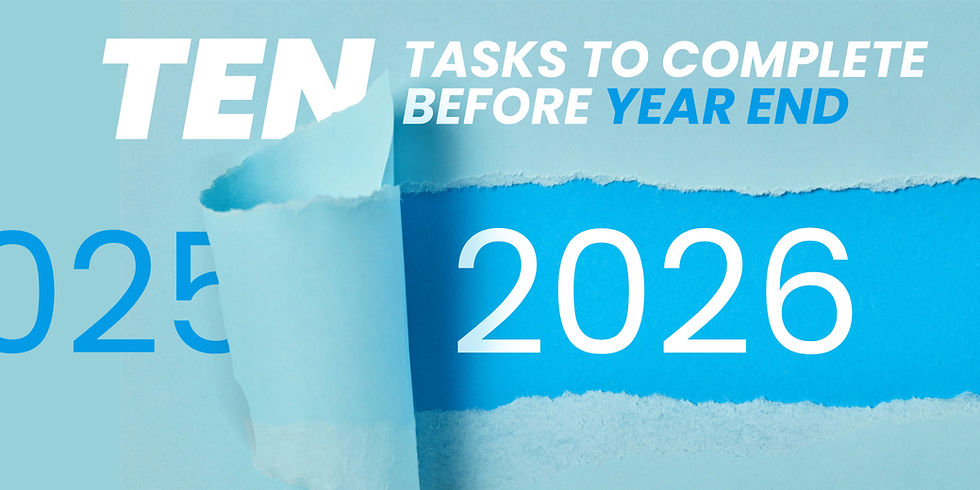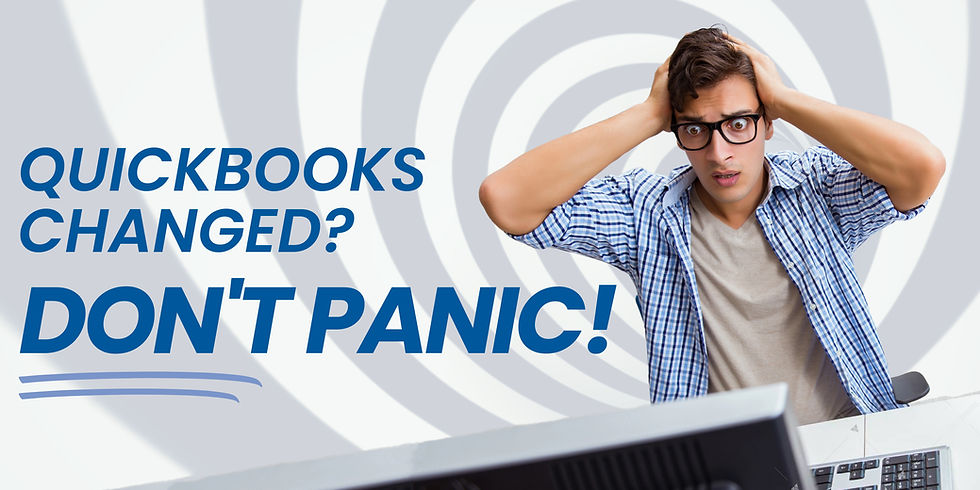What Do I Need For My 2020 Taxes? Here's a Handy Checklist
- Taylor Vanderburgh

- Mar 24, 2021
- 5 min read
It's tax season, folks. And the pandemic is only complicating things for 2020 filing.
T4A's, T5008, RRSPs - what does it all mean for you and your tax return?
Before you file, you'll need to get your numbers ready. This information is pulled from various forms, coming from different sources.
To make things easy for you, we've compiled a handy checklist outlining exactly what you need and where to get it from.
Basic Information to Get Started
First and foremost - you'll need everybody's basic information (legal name, date of birth, and most importantly, Social Insurance Number). You'll also need this for your spouse and any new dependents in 2020.
Changes to your marital status
Did you get married, legally separated or divorced in 2020? This information will determine if you will do a joint file or not.
Changes to your dependents
Did your dependents increase or decrease in 2020? Dependents include children under the age of 18.
Changes to your banking information
Did you open a new bank account this year? You certainly don't want your return going to an inactive account! If you receive your tax return via direct deposit, take a moment to modify this with the Canada Revenue Agency (CRA).
☐ T4 - Statement of Remuneration Paid from your Employer
Who Needs It: Anyone who was paid by an employer in 2020
Where to Get It: Will be issued and mailed/emailed by your employer
The T4 is the most basic of forms you'll need in order to file your 2020 return. You should have received this by March 1 of this year, from your employer. It will state how much you earned, and how much CPP, EI and income tax was deducted, as well as additional benefits or commissions paid.
Some new boxes for 2020 include boxes 57-60 for remuneration paid during the early period of the pandemic.
You may receive digitally via email or a hard copy via mail.
☐ T4E - Employment Insurance, Canada Emergency Response Benefit (CERB), and other benefits due to the pandemic
Who Needs It: Anyone who received EI, Maternity or Parental Benefits, or any of the COVID-19 benefits including CERB
Where to Get It: Will be issued and mailed by the CRA
If you received Employment Insurance (including Parental or Maternity Benefits), you will need a copy of your T4E.
Did you receive CERB? This was the $500/week (or $2000/month) benefit that was dispersed to eligible Canadians between March 15 and September 26, 2020.
Did you receive the second round CRB (Canada Recovery Benefit), CRCB (Canada Recovery Caregiving Benefit, or CRSB (Canada Recovery Sickness Benefit) at $500/wk September 27, 2020 to September 25, 2021?
CERB, CRB, CRCB and CRSB will be included in your 2020 income. You'll need a copy of your T4E if you received this benefit.
☐ T3, T5 and T5008 - Statements of Trust or Investment Income and Securities
Who Needs It: Those with investments outside of the RRSP or TFSA
Where to Get It: Will be issued by the organization or financial administrator of the company you've invested with.
If you have invested in mutual funds (not including your RRSP or TFSA), you will receive a T3 or T5 if the mutual fund earns income. Interest, dividends, and capital gains are included as this income.
If you "cashed in" on this income, you will receive a T5008 from your broker.
☐ Closing Documents for Sales and Purchases of Residences
Who Needs It: Anyone who purchased or sold a residence in 2020
Where to Get It: Your lawyer, realtor, and filing cabinet
If you purchased or sold a home, including your principal residence, keep a copy of the Closing Documents with your tax return. You will need to report it to the CRA, even though any capital gains are considered tax-free. If you sold a secondary residence, you also must report and the capital gains will be taxable.
☐ Registered Retirement Savings Plan (RRSP)
Who Needs It: Those contributing to an RRSP
Where to Get It: From your financial institution or plan provider
If you or your spouse contribute to an RRSP, the total contributions can be deducted from your taxable income.
☐ Business Income and Expenses
Who Needs It: Those who are self-employed
Where to Get It: Financial statements from your accountant, receipts from your filing system
If you're self-employed, you are eligible to claim business expenses. Make sure you gather this all before filing your taxes, including auto and home office expenses, and equipment purchases.
Have the following ready, if applicable:
Business Documents
☐ Balance Sheet
☐ Licenses and Permits
☐ Profit and Loss
☐ Receipts for Equipment Purchases and Dispositions
Auto Expenses
☐ Auto Loan Interest Statements
☐ Auto Repair and Maintenance Receipts
☐ Fuel Receipts
☐ Insurance Statements
☐ Lease Payment Statements
☐ Odometer Readings as at Jan 1, 2020 and Dec 31, 2020
☐ Registration Fees
Home Office Expenses
☐ Condo Fees
☐ Home Improvement Receipts
☐ Home Insurance Statements
☐ Home Repairs and Maintenance
☐ Property Taxes
☐ Utility Bills
☐ T776 - Statement of Real Estate Rentals
Who Needs It: Anyone with rental income from their properties
Where to Get It: From the CRA (you are responsible for completing it)
If you generate income by renting property, you will need to fill out a T776. The statement will help you calculate any expenses associated with the rental as well, including repair and maintenance costs.
Have the following ready, if applicable:
☐ Advertising expense receipts
☐ Bank statements showing interest and bank fees
☐ Condo fees
☐ Employee wages and contributions
☐ Improvement expense receipts
☐ Insurance statement
☐ Landscaping bills
☐ Licenses and permits
☐ Management fees
☐ Mortgage statement with interest
☐ Office expenses
☐ Professional fees (including legal and accounting)
☐ Profit and Loss report
☐ Property tax statements
☐ Repair and maintenance cost receipts
☐ Travel and auto receipts
☐ Utility bills
☐ T2202 - Tuition and Enrolment
Who Needs It: Students enrolled in courses and paying tuition
Where to Get It: From your educational institution
If you, your spouse, or dependents incurred any expenses for tuition in 2020, you'll want to include your T2202 with your return. This will be received from the qualifying educational institution you were enrolled with.
☐ Union or Professional Dues
Who Needs It: Those who pay dues to a union or professional organization for their employment
Where to Get It: From your union or qualifying organization
If you are part of a union or other professional organization, you can deduct your union dues or membership fees. Note that you cannot claim these dues and fees if your employer pays them on your behalf.
You can find the claimable amount in box 44 of your T4. You may also receive a statement from your union or professional organization; keep a copy with your return.
☐ T4A - Statement of Pension, Retirement, Annuity and Other Income
Who Needs It: Those collecting pensions, retirement allowance, annuities or other income
Where to Get It: From the payer of the income
The T4A is a catch-all slip to record any income not reported on a T4 or T4E. More than just for Canada Pension Plan or Old Age Security, it will be filed by the payer (including the government) for all kinds of income including death benefits, cash prizes, grants, and bankruptcy settlements. For a full list of income, see the CRA webpage on the T4A.
☐ Donations and Medical Receipts
Who Needs It: Anyone who made donations or incurred medical expenses
Where to Get It: From your filing cabinet
Charitable donations are tax-deductible, as are medical expenses in excess of 3% of your income.
☐ Childcare Expenses
Who Needs It: Anyone paying for care for dependents under 13 or disabled dependents
Where to Get It: From your care provider
If you paid for any childcare expenses in 2020, including pre-school, before or after school care, day care or summer camps, you may be eligible to deduct these from your return. Have the SIN or Business Number of the care provider handy on your receipts.
Ready to file?
If you're ready to file your 2020 tax return, take a look first at the CRA's list of all deductions, credits and expenses to find out which you can claim. This handy tool allows you to sort by category (for example, family and childcare, or disability) as well as search for provincial credits as well.



Comments